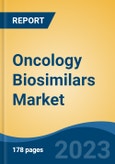Lung Cancer is the fastest growing segment, North America is the largest regional market
Speak directly to the analyst to clarify any post sales queries you may have.
10% Free customizationThis report comes with 10% free customization, enabling you to add data that meets your specific business needs.
Key Market Drivers
The increasing global incidence of cancer serves as a primary catalyst for the oncology biosimilars market, generating substantial demand for effective yet affordable treatment solutions. As the worldwide cancer burden rises, healthcare systems are compelled to seek cost-efficient therapeutic alternatives to manage growing patient populations and control expenditures. This rising prevalence directly drives the necessity for accessible oncology therapies, with biosimilars playing a pivotal role in expanding treatment access.Key Market Challenges
A significant challenge impeding the broader expansion of the Global Oncology Biosimilars Market is the substantial investment and intricate scientific expertise required for biosimilar development and manufacturing processes, alongside the necessity for extensive regulatory validation. This inherent complexity and considerable financial outlay directly deter potential manufacturers and prolong the market entry of oncology biosimilar products. The development pathway demands rigorous analytical characterization, preclinical evaluation, and clinical trials to establish biosimilarity to the original biologic, which is both capital-intensive and time-consuming.This challenging development environment limits the number of pharmaceutical companies capable of undertaking such programs, especially for complex oncology biologics. Consequently, many reference products, even after patent expiration, do not face biosimilar competition.
Key Market Trends
The growing acceptance and trust in clinical settings significantly influences the global oncology biosimilars market by fostering greater confidence among healthcare professionals and patients. This increased assurance directly translates into higher adoption rates for biosimilar treatments. According to the Association for Accessible Medicines, biosimilar medicines generated $20.2 billion in savings in 2024 alone, highlighting their crucial economic value which underpins broader acceptance. Furthermore, a survey conducted on behalf of the Alliance for Safe Biologic Medicines in August 2024, revealed that 88% of physicians agree switching studies enhance their confidence in the safety of transitioning patients from an originator medicine to an interchangeable biosimilar. This robust physician confidence is paramount for overcoming historical skepticism and driving market penetration.Key Market Players Profiled:
- Teva Pharmaceuticals Industries Ltd.
- STADA Arzneimittel AG
- Shanghai Henlius Biotech, Inc.
- Sandoz Group AG
- Samsung Bioepis NL B.V.
- Pfizer Inc.
- Ligand Pharmaceuticals Inc.
- Mylan Inc.
- Innovent Biologics (USA), Inc.
- Celltrion Inc.
Report Scope:
In this report, the Global Oncology Biosimilars Market has been segmented into the following categories:By Drug Class:
- Monoclonal Antibodies
- G-CSF
- Hematopoietic Agents
- Others
By Type of Cancer:
- Breast Cancer
- Lung Cancer
- Stomach Cancer
- Prostate Cancer
- Cervical Cancer
- Blood Cancer
- Brain Cancer
- Others
By Distribution Channel:
- Retail Pharmacies
- Hospital Pharmacies
- Online Pharmacies
By Region:
- North America
- Europe
- Asia-Pacific
- South America
- Middle East & Africa
Competitive Landscape
Company Profiles: Detailed analysis of the major companies present in the Global Oncology Biosimilars Market.Available Customizations:
With the given market data, the publisher offers customizations according to a company's specific needs. The following customization options are available for the report.Company Information
- Detailed analysis and profiling of additional market players (up to five).
This product will be delivered within 1-3 business days.
Table of Contents
Companies Mentioned
The companies profiled in this Oncology Biosimilars market report include:- Teva Pharmaceuticals Industries Ltd.
- STADA Arzneimittel AG
- Shanghai Henlius Biotech, Inc.
- Sandoz Group AG
- Samsung Bioepis NL B.V.
- Pfizer Inc.
- Ligand Pharmaceuticals Inc.
- Mylan Inc.
- Innovent Biologics (USA), Inc.
- Celltrion Inc.
Table Information
| Report Attribute | Details |
|---|---|
| No. of Pages | 185 |
| Published | November 2025 |
| Forecast Period | 2024 - 2030 |
| Estimated Market Value ( USD | $ 4.54 Billion |
| Forecasted Market Value ( USD | $ 6.79 Billion |
| Compound Annual Growth Rate | 6.9% |
| Regions Covered | Global |
| No. of Companies Mentioned | 11 |









